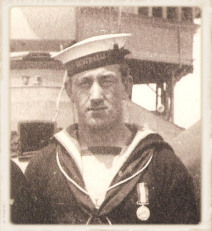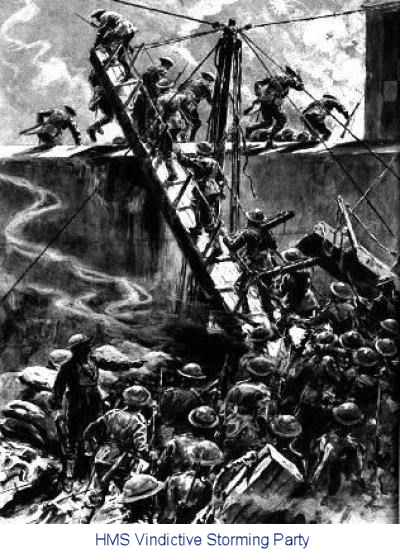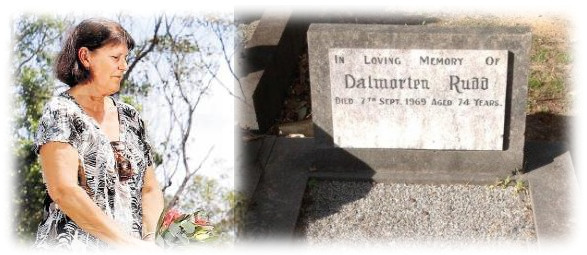
Navy Victoria
Network
Proudly supported by the Melbourne Naval Committee
Leading Seaman Dalmorton Joseph Owendale Rudd DSM
|
Rudd initially undertook his basic naval training at HMAS Cerberus, the depot at Williamstown in Victoria, from November 1913 until late April 1914 and then joined the light cruiser HMAS Melbourne on 26 April 1914. His time in Melbourne was brief as on 10 June 1914 he was posted to the battle cruiser HMAS Australia. On 14 June 1914 he was automatically promoted to Ordinary Seaman on attaining 18 years of age. Dalmorton Rudd was to serve in Australia for the remainder of his naval career. After the outbreak of war in August 1914 Australia saw extensive service in the Pacific and took part in the capture of German New Guinea in September 1914. The battle cruiser then steamed across the Pacific in search of the German East Asian Squadron and then entered the South Atlantic Ocean on 1 January 1915. In late January 1915 Australia arrived in Britain and was attached to the Royal Navy for service in the North Sea. Rudd was promoted to Able Seaman on 18 August 1915. HMAS Australia missed the battle of Jutland on 31 May 1916 due to be in dock for repairs following a collision with HMS New Zealand on 22 April 1916. The majority of her work throughout 1915-18 was patrolling the North Sea as part of the 2nd Battle Cruiser Squadron; escorting convoys from Norway to Britain and searching for the elusive German fleet which often remained in port. Rudd was promoted to Leading Seaman on 12 December 1917, at age 21, and all indications were that he had a promising career ahead of him. In October 1917 his younger brother, Stoker Leonard Rudd, joined Australia after having served in HMAS Melbourne since September 1914. In late February 1918 volunteers were call for from the fleet for a "dangerous venture" and Rudd was one of 11 men from Australia selected for this activity. The mission was the British raid on the port of Zeebrugge, in German occupied Belgium, on the night of 22-23 April 1918. This port was used as a base by German U-boats and destroyers operating in the English Channel and the Royal Navy undertook an operation to block the port by sinking three old cruisers, as block-ships, in the Bruges Canal.
On 1 March 1918, Rudd was technically posted to HMA London Depot, but actually dispatched with the other volunteers from Australia to the naval depot at Chatham for training as naval infantry. On 22 April 1918, Rudd was one of five RAN ratings aboard HMS Vindictive, which was tasked with landing storming parties on the breakwater at Zeebrugge, known as the Mole. The Mole had been transformed into a seaward outpost of the German coastal defence system and, for all intents and purposes, was a minor fortress. The storming parties were to capture the Mole and disable the German guns on it thus allowing the block-ships to steam into the port and reach the canal where they would be sunk.
Rudd was awarded the Distinguished Service Medal (DSM) for his bravery during the raid and later participated in the ballot for the award of a Victoria Cross (VC), because the collective bravery of the units involved in the Zeebrugge raid was considered to be deserving of the award. The use of the ballot system for the VC enabled the men who had taken part in the action to vote for an officer and rating to be awarded the VC. As a result of the ballot a Royal Navy and a Royal Marine officer and a Royal Navy rating and a Royal Marine were each awarded a VC as voted by their peers. Rudd took part in this ballot and could have been awarded a VC but instead received the DSM which was gazetted on 23 July 1918. Leading Seaman Rudd returned onboard Australia after the Zeebrugge action and continued to serve in the ship until the end of the war. On 11 November 1918 the Armistice was declared and ten days later the German fleet surrendered. Australia had the honour of leading the port escort column as the German High Seas fleet surrendered at Scapa Flow.
Rudd married a 27 year old widow, Isabel Whitley, who he had met some months before, at Leeds, Yorkshire in January 1919 but less then two months later she died of pneumonic influenza. Australia departed England for return to Australia on 23 April 1919. For many onboard like Rudd they were returning home after an absence of over four years. On the voyage home the battle cruiser called at the port of Aden in early May. No leave was granted to the crew and Rudd, still coming to grips with the recent loss of his wife, obtained alcohol from ashore and was found onboard drunk. On 12 May 1919 Dalmorton Rudd was reduced to the rank of Able Seaman. On 28 May 1919, HMAS Australia arrived in the port of Fremantle, the first Australian port that the ship had visited since late 1914. Shore leave was granted to the men who enjoyed themselves after four long years of war service. On 1 June 1919, however, when Australia was due to depart Fremantle for port visits to Adelaide, Melbourne and finally Sydney, a large number of the crew attempted to convince the Commanding Officer, Captain Claude Cumberlege, to keep the ship in port longer so the men could repay the people of Fremantle for the rousing reception they had received. Cumberlege took the then unprecedented step of addressing the men personally and advising them the situation was out of his hands as the ship had a schedule to meet with other port visits. But when he tried to take the ship to sea a number of masked men entered the stokehold and convinced the Stokers to abandon their post - which they did. Cumberlege managed to get the ship to sea using senior engine room ratings to stoke the ships boilers. Several ratings were subsequently arrested for mutiny including Dalmorton Rudd and his younger brother Leonard. The Rudd family also suffered further tragedy on 1 June 1919 when 15 year old Royston Rudd died from a congenital heart disorder. The vagaries of communications in those days, however, meant it was several weeks before the information of their younger brother’s death reached Dalmorton and Leonard Rudd. Australia arrived in Sydney on 15 June and a Court Martial was soon held onboard the cruiser HMAS Encounter. On 19 June 1919, five mutineers were found guilty of committing a mutiny not accompanied by violence; all five men had plead guilty at the start of the trial and admitted regret for their conduct. Dalmorton Rudd was sentenced to be dismissed from the Navy and to 18 months imprisonment, with hard labour, at Goulburn Gaol. His brother Leonard received a two year sentence, with hard labour, as well as dismissal from the RAN. The sentences were considered excessively harsh and there was a public outcry which the media soon enhanced. Prime Minster William Hughes discussed the matter with the Naval Board and eventually when they refused to accede to his request to release the men, he bypassed them and went straight to the Admiralty with the same request. The British Authorities agreed with his request and recommended the men be released. Hughes ordered the men to be released, but the 1st Naval Member (Rear Admiral Sir Edmund Grant) and the Fleet Commander Rear Admiral JS Dumaresq resigned in protest. Both officers later revoked their resignations, but Hughes decision was upheld. The five mutineers were released from Goulburn Gaol on 20 December 1919. Despite being dismissed from the Navy there is no evidence that Dalmorton Rudd was stripped of his DSM and his name still currently appears on the Australian Honours and Awards database. His war gratuity (a bonus paid to members of the Australian Forces for war service) was also paid in late 1920 although members who had been dismissed from the service normally forfeited this privilege.
Rudd then sought out employment as a labourer in Sydney. On 20 November 1920 he married 22 year old Irene Weston at Marrickville. Their first child, Edwin ‘Teddy’ Dalmorton Rudd, was born in April 1921, then a daughter Valvy (Doreen) in June 1923, and another daughter Mavis Irene in October 1929. The Rudd household was not always a happy one and Dalmorton and Irene became estranged and eventually divorced. During World War II Dalmorton Rudd was a stevedore working on the docks in Sydney Harbour. His younger brother Leonard served in 2nd AIF from April 1940 until March 1944, and his son Edwin served in the 2/5th Infantry Battalion from December 1942 until his discharge in September 1946. Dalmorton Rudd married 52 year old divorcee Mary Magdalene Hanley (née Roach) at Redfern on 30 June 1945. Rudd and his new wife resided at Darlington in Sydney, but following his retirement they moved to the small village of Patonga on the NSW Central Coast. Rudd was a keen fishermen in his spare time.
"I remember him saying while they were waiting to go fellows were literally shitting themselves," he said. "I asked if that included him. He said 'I was shitting myself so much there was nothing left'." Dalmorton Rudd died as the result of a small boat accident in Broken Bay, NSW on 7 February 1969. While his death was attributed to drowning, an eyewitness indicated that Dalmorton Rudd had suffered a stroke and collapsed at the tiller of his boat which then ran aground on Lion Island and sank. He was subsequently buried in the General Cemetery at Point Clare on the NSW Central Coast. His brother Leonard Rudd died from cancer in July 1969.
|
 Leading
Seaman Dalmorton James Owendale Rudd was born on 14 June 1896 in the
Sydney suburb of Campsie, the eldest son of Joseph Dalmorton Rudd
and Annie Elizabeth Rudd (née Fleming). He joined the RAN as a
17-year-old Ordinary Seaman 2nd Class on 30 October 1913 and was
allocated service number 3389. His younger brother Leonard
Thomas Rudd (born in July 1898) joined the RAN, as a 15-year old
HMAS Tingira Boy 2nd Class, only a few days later on 5
November 1913.
Leading
Seaman Dalmorton James Owendale Rudd was born on 14 June 1896 in the
Sydney suburb of Campsie, the eldest son of Joseph Dalmorton Rudd
and Annie Elizabeth Rudd (née Fleming). He joined the RAN as a
17-year-old Ordinary Seaman 2nd Class on 30 October 1913 and was
allocated service number 3389. His younger brother Leonard
Thomas Rudd (born in July 1898) joined the RAN, as a 15-year old
HMAS Tingira Boy 2nd Class, only a few days later on 5
November 1913.
 Vindictive came under intense enemy fire as she approached
the Mole, suffering heavy casualties, including most of the officers
in charge of her storming parties. Once ashore the men found
that Vindictive had overshot her assigned position and that
the original objective of rushing the Mole gun battery was
impossible. The objective then changed to one of holding
ground as a diversionary measure while under withering enemy fire;
which caused heavy casualties amongst the storming parties.
With the other ships involved in the raid achieving their respective
objectives the recall was sounded and Vindictive made good
her escape. Over 1700 officers and men took part in the
Zeebrugge raid; 220 were killed, 350 wounded and a dozen men taken
prisoner.
Vindictive came under intense enemy fire as she approached
the Mole, suffering heavy casualties, including most of the officers
in charge of her storming parties. Once ashore the men found
that Vindictive had overshot her assigned position and that
the original objective of rushing the Mole gun battery was
impossible. The objective then changed to one of holding
ground as a diversionary measure while under withering enemy fire;
which caused heavy casualties amongst the storming parties.
With the other ships involved in the raid achieving their respective
objectives the recall was sounded and Vindictive made good
her escape. Over 1700 officers and men took part in the
Zeebrugge raid; 220 were killed, 350 wounded and a dozen men taken
prisoner.

 Rudd's
grandson, Ray Hanley, said his grandfather spoke about the raid only
once, while the two were fishing off the Central Coast about six
years before Rudd died. He remembers Rudd talking about how
scared men were.
Rudd's
grandson, Ray Hanley, said his grandfather spoke about the raid only
once, while the two were fishing off the Central Coast about six
years before Rudd died. He remembers Rudd talking about how
scared men were.